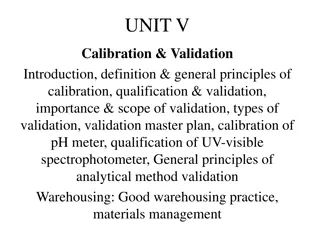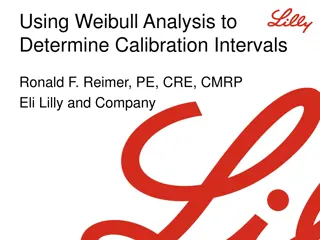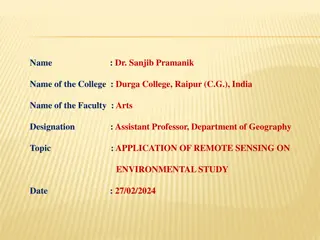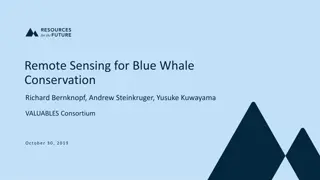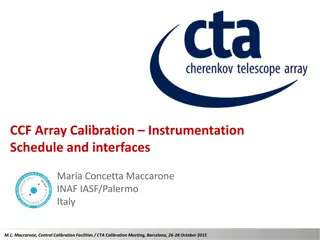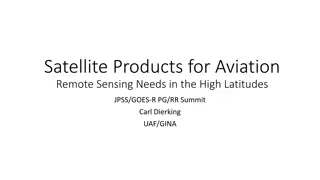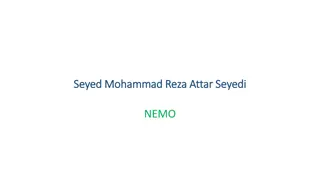Ocean Optics Class 2013: Calibration & Validation for Remote Sensing
This class in 2013 focused on calibration and validation for ocean color remote sensing, featuring instructors like Emmanuel Boss and Mary Jane Perry. From historical insights to the key to the class's success, the curriculum provided a learning community emphasizing hands-on experience, critical analysis, and data processing techniques. Students engaged in fieldwork to gather and process data, contributing to the advancement of ocean sciences through optical signals and biogeochemical properties.
Download Presentation

Please find below an Image/Link to download the presentation.
The content on the website is provided AS IS for your information and personal use only. It may not be sold, licensed, or shared on other websites without obtaining consent from the author. Download presentation by click this link. If you encounter any issues during the download, it is possible that the publisher has removed the file from their server.
E N D
Presentation Transcript
Welcome to 2013 Ocean Optics Class SMS 598: Calibration and Validation for Ocean Color Remote Sensing, 8 July 2 August 2013 Instructors: Emmanuel Boss and Mary Jane Perry UMaine Curt Mobley Sequoia Scientific Collin Roesler Bowdoin College (weeks 1 & 2) Ken Voss U. Miami (weeks 1 3) Jeremy Werdell NASA Goddard (weeks 3 & 4) Ron Zaneveld WET Labs (weeks 3 & 4) TA: Ali Chase UMaine Help from: Nathan Briggs, Ivona Cetinic, Jim Loftin UMaine Class website: http://misclab.umeoce.maine.edu/~optics/
Welcome to Maine Maine facts: Population (2009): 1.33 million Coastline: 5300 miles Area: 35,387 miles2 + 4,523 miles2 of inland waters. Seasons: Tourist, Foliage, Ski, & Mud (some further subdivide it according to prevaling pests). Welcome to Maine
History of the Ocean Optics class 1985, 1987, 1989, 1995, 1998, 2001, 2004, 2007, 2011 and now 2013. This is 10th class! MJP started it w/ Ken Carder; CR was student that year. EB was student 1995. CM joined in 1995. Jermey Werdell & Ken Voss joined 2011. O(150) graduates, including Paula Bontempi at NASA Many graduates are leaders in their fields: Ray Najjar, Dennis McGillicuddy, Heidi Sosik, to name a few. Evolution and highlights: 1985: 1 Spec, 1 PAR sensor, a spectral transmissometer, turner. 1987: 1 computer, FCM 1989: symposium + book 1995: Hydrolight 1998: hyper-spectral overflights. Special Ocean Sciences session. 2001: moved to Maine. 2007: Ocean Optics Web book (http://www.oceanopticsbook.info/).
Key to the Classs Success Requirement for team work, each with his/her own focus. Collaborative environment. Learning community. Networking. Contribute to advancement of ocean sciences through ocean optics. First few weeks: animated lectures in morning; related lab in afternoon covering basic concept (e.g. NPQ), use of instruments and their calibration. Strong emphasis on relating optical signal to biogeochemical properties, critical thinking, critical analysis of data, hands-on experience. Cruise experience: collecting data in the field and processing it; learning how to submit documented data to SeaBass.
Logistics: safety, internet, meals, linen, Maine activities, etcetera Tim Miller lab administrator Linda Healy events coordinator Course schedule and syllabus Daily student reporting and summary of previous day s lab Saturday morning more on Student U tube project (building on 2011 portfolio)
Week I schedule see syllabus Day 1 (Mon) July 8 Welcome to Maine and the Darling Center Logistics and overview Introductions and Lectures Lunch Introductions, part II Labs Day 2 (Tue) July 9 Lectures and Labs Day 3 (Wed) July 10 Lab report: CDOM lab synthesis and summary Lectures and Labs Day 4 (Thu) July 11 Lab report: Particulate absorption lab synthesis and summary Lectures and Labs Day 5 (Fri) July 12 Lab report: Fluorescence lab Lectures and Labs Day 6 (Sat) July 13 (start at 0900) Lab report: Scattering lab synthesis and summary Synthesis of 1st week: critique process of learning, Q&A on any topic; tie up loose ends Student U tube project (building on 2011 portfolio) Chlorophyll fluorescence in-class exercise: without answers and with answers Dinner Bar-B-Que at DMC
INTRODUCTIONS work with a fellow student over lunch; introduce that students to the class after lunch NAME of person you are introducing: WHERE she or he comes from (state/country and school or institution): THE PAST something about the person s background that resulted in him/her being in this course: THE FUTURE something about her/his future plans, that he/she hopes the course will help in achieving: THE PRESENT something that she/he wants to get of this course and how everyone else can contribute to this experience (it might be asking for help in something challenging): THE UNEXPECTED something that we would never guess about the person s activities, skills, or interests:
satellite radiometry In-water optical properties; surrogates real entity (cell, POC, etc.) ecosystem; carbon cycle; climate system; fisheries; HABs; etc.
Sampling strategy must include appropriate spatial/temporal scales. Understanding marine biogeochemical cycles and ecosystems on regional-to-global scales requires calibrated, validated satellite ocean color data. Use measurement measurement closure and measurements model closure to reduce uncertainty. Successful satellite cal/val depends on high quality, in-water measurements.




